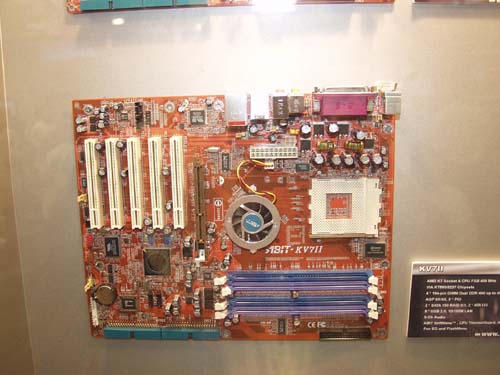Computex`2004: Mobo Foxconn
The most powerful and efficient motherboard (and thus must be the most expensive) in Abit's assortment is the AA8 DuraMAX model which yesterday arrived at our test lab, and soon we're publishing a full-featured review:
It is built on the i925X chipset, with the ICH6R used as the south bridge. The board offers the following specifications:
- Support for Socket LGA775 (800 FSB) processors
- Memory: 4 slots (two channels) for DDR2-533 (MAX 4Gb)
- RAID: 4 channels for SerialATA (RAID 0,1, 0+1)
- LAN: Gigabit Ethernet
- USB2.0: 8 ports
- Firewire: 3 ports
- PCI x16 Express Graphics: 1 slot
- PCI x1 Express: 3 slots
- "regular" PCI: 2 slots
- 8-channel integrated audio (SP-DIF In\Out)
Frankly, compared to the top-end models by Asus and Gigabyte, this board looks quite mean. The competitor products offer wider choice of expansion options (e.g., two Gigabit LAN controllers, greater number of SerialATA channels (up to 8), support for Firewire-800, etc.).
The following two motherboards are built on the i915P chipset and made on the same PCB design. The boards are called AG8 Pro and AG8. The former is more "advanced": it offers support for the DDR2 memory, whereas the the AG8 is aimed at using with the DDR memory.
Note that Abit decided not to develop a board with simultaneous support for DDR and DDR2 - Intel warns it won't be responsible for unstable operation of such boards. But the company engineers invented quite a tricky thing: Guru Clock. This is an external LCD where various system information is displayed (temperature of the processor, system, environment, processor's clock speed, voltage levels, time etc.). Besides, the device can give warning of a newly arrived email or Windows Messenger message.
The Guru Clock can also control the processor's clock speed, i.e. overclock the system without entering the BIOS settings, or the OC Guru utility. By the way, the overclocking utility Abit OC Guru has acquired the additional feature - AutoDrive. This is another version of "dynamic overclocking", which allows increasing the system performance as load to the processor goes up.
The next board is AS8. It features in that it is built on the i865PE chipset + ICH5R, but supports Socket LGA775 processors.
This product is ideal for users who have a powerful AGP video card and high-quality DDR memory, and intend to migrate to the LGA775 at minimum cost. Remember that when migrating to the i925X\i915P the video card has got to be replaced (with PCI Express only), the same applies to memory (only DDR2 for i925X, and i915P for some models).
Now let's see what Abit offers to those users who are unwilling to deal with a brittle processor socket and the fire-spitting Prescott. I mean motherboards for AMD processors.
The flagship AMD model is Abit AV8 aimed at Athlon64 Socket939 processors. Here are the brief specifications:
- Chipset: VIA K8T800 Pro + VT8237
- Memory: 4 slots (two channels) for DDR400 (MAX 4Gb)
- AGP: 1 slot for AGP8XX
- PCI: 5 slots
- RAID: 2 channels for SerialATA (RAID 0,1, 0+1)
- LAN: Gigabit Ethernet
- USB2.0: 8 ports
- Firewire: 3 ports
- 6-channel integrated audio (SP-DIF In\Out)
For Socket754 processors, Abit offers KV8 Pro which is also built in the VIA K8T800 Pro chipset + VT8237:
In fact, this board offers the same specifications as AV8, except the DIMM slots. They are merely two, since the integrated memory controller in Socket754 processors is single-channel.
The next board is aimed at the fading SocketA market. This is Abit KV7 II based on the dual-channel VIA KT880+ VT8237 chipset.
 The inquisitive reader might ask - "Where on earth are motherboards on nVidia chipsets???" For example, на nForce3 1500; CK804". There aren't. Half a year ago, the situation didn't cause any questions: for a small quantity of little promising Athlon64 Socket754 processors, each second-rank manufacturer produced a motherboard. As the chipsets, the nForce3 150 or VIA K8T800 were used. However, sales of Athlon64 are gaining pace (especially, after the release of 2800+), and the lack of interesting (in terms of overclocking) motherboards built on nForce3 250 arouses questions. The situation turned more entangled after Abit's official announcement of poor stability of the nForce3 250 chipset. In fact, high politics may have been involved in that: in due time, Abit quite seriously quarreled with nVidia and even ceased production of video cards on NVIDIA chips, and now the latter has reduced supply volumes of the most recent chipsets.
Anyway, the situation absolutely doesn't relate to the nVidia nForce2 400 Ultra chipset which acquired the new Gigabit MCP south bridge. Based on this combination, Abit designed the NF7 S2G motherboard.
In conclusion, I'd like to note that I like Abit's expo stand most. It was put up away from the major visitor flows and designed in a very smart way. What matters is that I could easily find out what I wanted in the quiet atmosphere using my native Russian :)))
 Vika (Abit Taiwan)
Vika (Abit Taiwan)
 |
Content: |
 |
|
 |
Top Stories: |
 |
 |
 |
MoBo:


|
 |
 |
 |
VGA Card:


|
 |
 |
 |
CPU & Memory:

|
|
|
